March Madness is upon us! While some people's thoughts turn towards basketball, brackets, and buzzer-beaters, we in the weather community have our own March Madness event: a challenge amongst US states to sign up as many new observers as possible for a program known as CoCoRaHS. CoCoRaHS, the Community Collaborative Rain, Hail, and Snow Network, is a citizen-based project in which observers measure precipitation at their home or business using a standard, high-quality rain gauge (Figure 1) and report their daily totals each morning via the project’s web site or through the CoCoRaHS app. CoCoRaHS aims to accurately determine where and how much precipitation falls across North America. CoCoRaHS began in 1998 at Colorado State University. Kansas was the third state to join back in 2004. 2023 marked the 25th anniversary of the project.

Figure 1: The official CoCoRaHS rain gauge. Photo by Matthew Sittel, K-State Research and Extension.
CoCoRaHS in Kansas
Our recruitment efforts last year were quite successful. We added over 80 new observers during March Madness, the sixth-highest count of any state. This was our best showing and was more than double our previous high count. Overall, in 2023, we added just over 300 new reporters. As of March 4, 2024, we have received at least one daily CoCoRaHS report from 839 different observers. This represents about a 10% increase in reports over this time last year.
We are grateful for all of our observers, but we still need more help to improve our coverage of the entire state. Despite a count that averages out to 8 observers per county, there are five counties in Kansas with no active observers: Greeley, Haskell, Linn, Morton, and Woodson (Figure 2). There are 27 more counties with three or fewer observers. Why is statewide coverage so important? The Kansas Climate Office uses precipitation reports (rain, snow, and ice) to assess drought conditions across Kansas. Without reports, we have no idea exactly how much rain fell or exactly where it fell and where it didn’t, which makes it more difficult to determine drought status properly. We occasionally hear from people who point out that the weekly US Drought Monitor map, which our office contributes weekly, doesn’t accurately reflect conditions at their location. We often have no reported rainfall, or lack thereof, from their location. We are only as good as the data we receive!
In the wetter months, thunderstorms may impact one part of a county or just one city and not another. Without CoCoRaHS, our knowledge is limited to the few reports we get from airports and cooperative observers. We are missing a lot of territory with so few reports. That’s where CoCoRaHS is invaluable. Your reports are not just for the Kansas Climate Office; other agencies, such as the National Weather Service and county and local agencies, use the information to track flooding risk, municipal water supplies, groundwater availability, lake levels, and river stream flows.

Figure 2. Counts of active CoCoRaHS observers in each county across Kansas as of March 4, 2024.
Users who visit the CoCoRaHS website can view tables and maps of precipitation amounts (Figures 3 & 4) for any or all locations in the United States. Users can also view totals for varying time periods, from days to months. Every CoCoRaHS report received further improves the quality of the products, but there are still spatial and temporal gaps in the data where there are no observers. That’s where you come in; we need your help to increase coverage across the state! The best part of CoCoRaHS, at least for Kansans, is that we provide the standard rain gauge free of charge to new observers who request one. We are the only state in the nation that does this. The reason for this is simple: the observational data we receive from our observers is invaluable to our mission to serve Kansas. It’s a great partnership: we supply the rain gauges, you supply the data, and together, we help our fellow Kansans.

Figure 3. Total precipitation map from the CoCoRaHS web page for the 24 hours ending at 7 AM CST on February 4, 2024.

Figure 4. Tabular display of 24-hour precipitation data from the CoCoRaHS website on February 4, 2024.
Join CoCoRaHS
We hope you’ll consider joining CoCoRaHS; visit cocorahs.org to learn more about the project and to become an observer. Help us track the weather across Kansas; join CoCoRaHS today!
Matthew Sittel, Assistant State Climatologist
msittel@ksu.edu